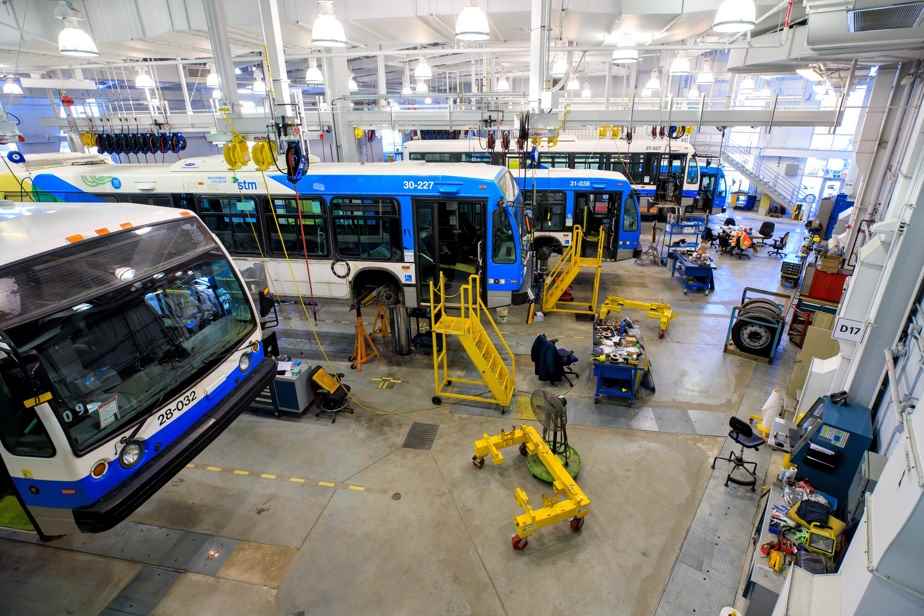“A bus will spend perhaps a month here, depending on its condition,” says the superintendent of major maintenance, Jean Vandenbroek. Behind him, STM buses suspended from large maintenance infrastructures. In this garage, nearly 75 vehicles have their engines replaced every year.
“A bus will spend perhaps a month here, depending on its condition,” says the superintendent of major maintenance, Jean Vandenbroek. Behind him, STM buses suspended from large maintenance infrastructures. In this garage, nearly 75 vehicles have their engines replaced every year.
In total, approximately 150 buses pass through it every year to be refurbished.
As a general rule, an STM bus has a useful life of approximately 16 years, provided it is kept in good condition.
What we see arriving in our garages are mainly buses that have seven or eight years of service. It’s a bit like with a car: after a while, the engine, there’s nothing more to do with it. It needs to be changed.
Jean Vandenbroek, major maintenance superintendent
More than 25 employees daily uninstall the motors from the buses, clean them, repair them and then reinstall them. Opposite, the same principle is applied to metro cars, on a vast site located very close to the Metropolitan highway.
-

PHOTO ALAIN ROBERGE, THE PRESS
Each year in the workshop, the engine blocks of approximately 150 STM buses are replaced or refurbished.
-

PHOTO ALAIN ROBERGE, THE PRESS
Each year in the workshop, the engine blocks of approximately 150 STM buses are replaced or refurbished.
-

PHOTO ALAIN ROBERGE, THE PRESS
Each year in the workshop, the engine blocks of approximately 150 STM buses are replaced or refurbished.
-

PHOTO ALAIN ROBERGE, THE PRESS
Each year in the workshop, the engine blocks of approximately 150 STM buses are replaced or refurbished.
-

PHOTO ALAIN ROBERGE, THE PRESS
Each year in the workshop, the engine blocks of approximately 150 STM buses are replaced or refurbished.
1/5
From one bus to another, it’s different. “It may be that after five years, a bus is brought in for maintenance, often due to an unforeseen breakage. On the other hand, there are some that will last 10 years without being really rebuilt. We even have buses that are almost 12 years old with the original engine,” adds Stéphane Gauthier, maintenance engineering technician.
“Sometimes it pays more to do maintenance before the end of the vehicle’s useful life, because if it doesn’t go there, you put a lot of money for just a few years of useful life. In other words, here, we catch the shelter before it breaks”, illustrates for his part the mechanical engineering technician François Zangger.

PHOTO ALAIN ROBERGE, THE PRESS
Francois Zangger, Mechanical Engineering Technician, Jean Vandenbroek, Major Maintenance Superintendent, and Stéphane Gauthier, Maintenance Engineering Technician
In total, the STM currently has a fleet of 2,030 buses, of which 836 are hybrid and 42 are electric.
Since September, the Crémazie workshop team has moved into brand new, state-of-the-art facilities.
Seven other maintenance workshops do the same work at the STM. Once refurbished, the buses returned to their transport hub, to hit the road again. “And then the cycle resumes”, illustrates Jean Vandenbroek, with a smile on his face. The manager knows one thing, however: the future will dramatically change his daily life and that of his maintenance teams.
-

PHOTO ALAIN ROBERGE, THE PRESS
Since September, the maintenance team has moved into new state-of-the-art facilities.
-

PHOTO ALAIN ROBERGE, THE PRESS
Since September, the maintenance team has had brand new state-of-the-art facilities.
1/2
The challenge of electrification
Like most transport companies, the STM is indeed aiming for the complete electrification of all its buses by 2040. Beyond the organizational challenge behind such a measure, it also involves a whole challenge of training the workforce. work.
For us, this is going to be a complete change, both in terms of our operations and the health and safety of our world. We are going to be one of the largest electric fleets in Quebec.
Stéphane Gauthier, maintenance engineering technician
“The challenge will be training and acquiring knowledge. Everything is to be done. Even in the manufacturing sector: everything is new for them,” confides Mr. Gauthier on this subject.
An electric bus runs on average on 600 volts of power, also recalls Mr. Zangger. “At this level, the chances of electrocution are real. The employee who maintains it must therefore be trained, reformed and certified. And there’s a lot of equipment that comes with that. This is not to be taken lightly,” he says.
“It is certain and certain that over time, there will be fewer diesel mechanics at the STM, and many more mechanics with an electrical orientation,” continues the engineer. “The technology has already come in, but we are still taken with the fact that we have to retain knowledge for 16 years of technology. From the oldest to the newest, we have to be able to control all these technologies, ”he further illustrates.
In its most recent annual budget, the STM set aside $4.4 billion – spread over 10 years – for the purchase of additional electric buses. In 2023 alone, no less than 147 long-range electric buses are to be purchased.
